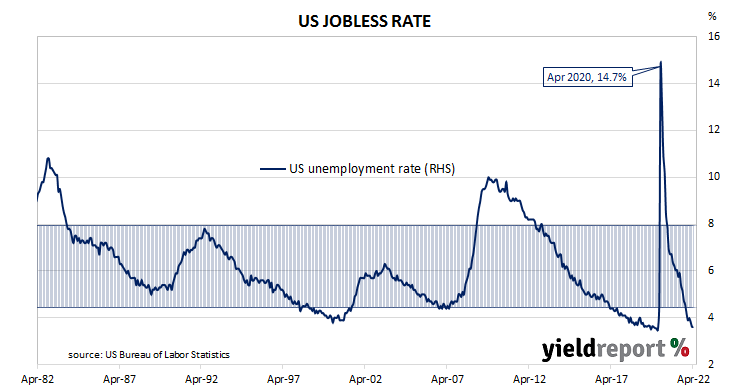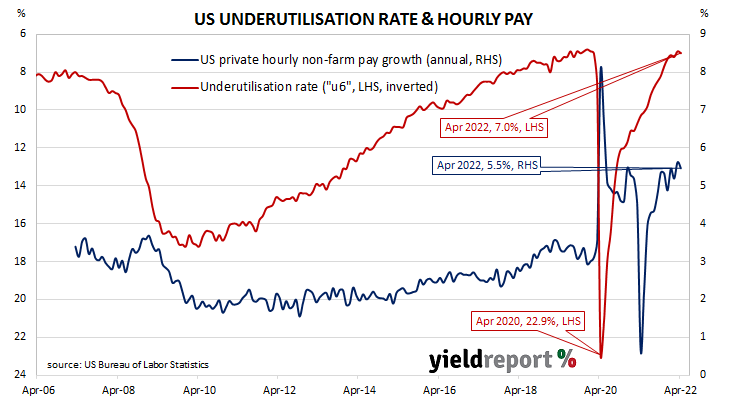Summary: Non-farm payrolls increase by 428,000 in April; slightly greater than expected figure; previous two months’ figures revised down by 39,000; jobless rate steady at 3.6%, participation rate down; jobs creation inconsistent with Fed’s inflation view if continues; jobs-to-population ratio declines; underutilisation rate ticks up to 7.0%; annual hourly pay growth slows to 5.5%; small fall in participation rate implies no increase in labour supply, will underpin wages growth.
The US economy ceased producing jobs in net terms as infection controls began to be implemented in March 2020. The unemployment rate had been around 3.5% but that changed as job losses began to surge through March and April of 2020. The May 2020 non-farm employment report represented a turning point and subsequent months provided substantial employment gains. Changes in recent months have been generally more modest but usually well above the long-term monthly average.
According to the US Bureau of Labor Statistics, the US economy created an additional 428,000 jobs in the non-farm sector in April. The increase was slightly greater than the 390,000 which had been generally expected earlier in the week but in line with the 428,000 jobs which had been added in March after revisions. Employment figures for February and March were revised down by a total of 39,000.
The total number of unemployed decreased by 11,000 to 5.941 million while the total number of people who are either employed or looking for work decreased by 0.364 million to 163.995 million. These changes led to the US unemployment rate remaining stable at April’s rate of 3.6%. The participation rate declined from March’s revised rate of 62.4% to 62.2%.
“If this strength in jobs creation continues, it will be inconsistent with the Fed’s inflation view and guidance that a 75bps rate rise is not on the table,” said ANZ Head of Australian Economics David Plank.
Longer-term US Treasury yields increased noticeably on the day. By the close of business, the 10-year yield had gained 10bps to 3.14% and the 30-year yield had added 11bps to 3.23%. The 2-year yield finished unchanged at 3.23%.
In terms of US Fed policy, expectations for a higher federal funds rate over the next 12 months softened somewhat. At the close of business, June contracts implied an effective federal funds rate of 1.11%, 28bps higher than the current spot rate. July contracts implied 1.44% while May 2023 futures contracts implied an effective federal funds rate of 2.23%, 140bps above the spot rate.
One figure which is indicative of the “spare capacity” of the US employment market is the employment-to-population ratio. This ratio is simply the number of people in work divided by the total US population. It hit a cyclical-low of 58.2 in October 2010 before slowly recovering to just above 61% in late-2019. April’s reading declined from 60.1% to 60.0%, still some way from the April 2000 peak reading of 64.7%.
Wage growth spiked in the US during the early stages of pandemic restrictions as lower-paid jobs disappeared at a faster rate relative to higher-paid jobs, disrupting the usual relationship between wage inflation and unemployment rates. Normally, wages tend to grow as the supply of labour tightens.
Apart from the unemployment rate, another measure of tightness in the labour market is the underutilisation rate. The latest reading of it ticked up from 6.9% in March to 7.0%. Wage inflation and the underutilisation rate usually have an inverse relationship and hourly pay growth in the year to April slowed from March’s revised rate of 5.6% to 5.5%.
Plank noted “a small fall in the participation rate implies no increase in labour supply from this source. That will underpin wages growth.”



